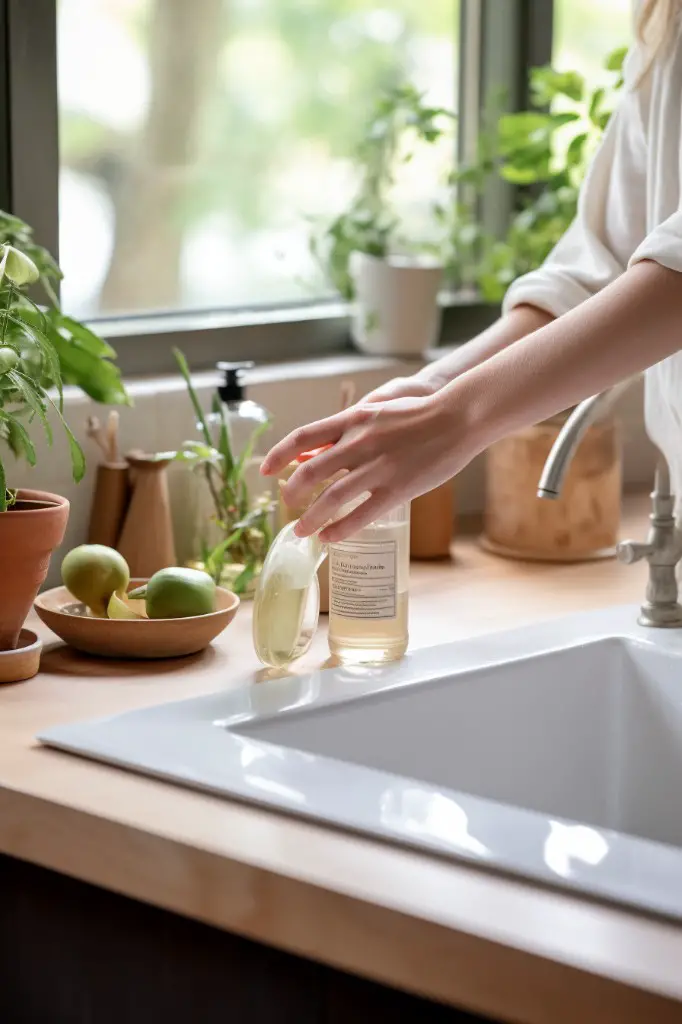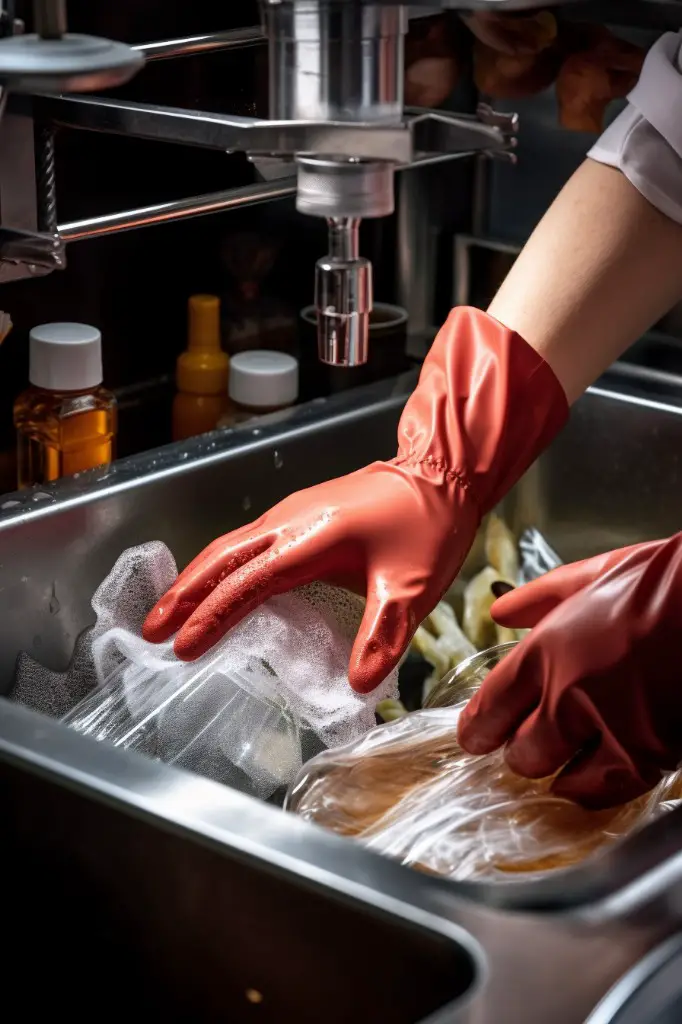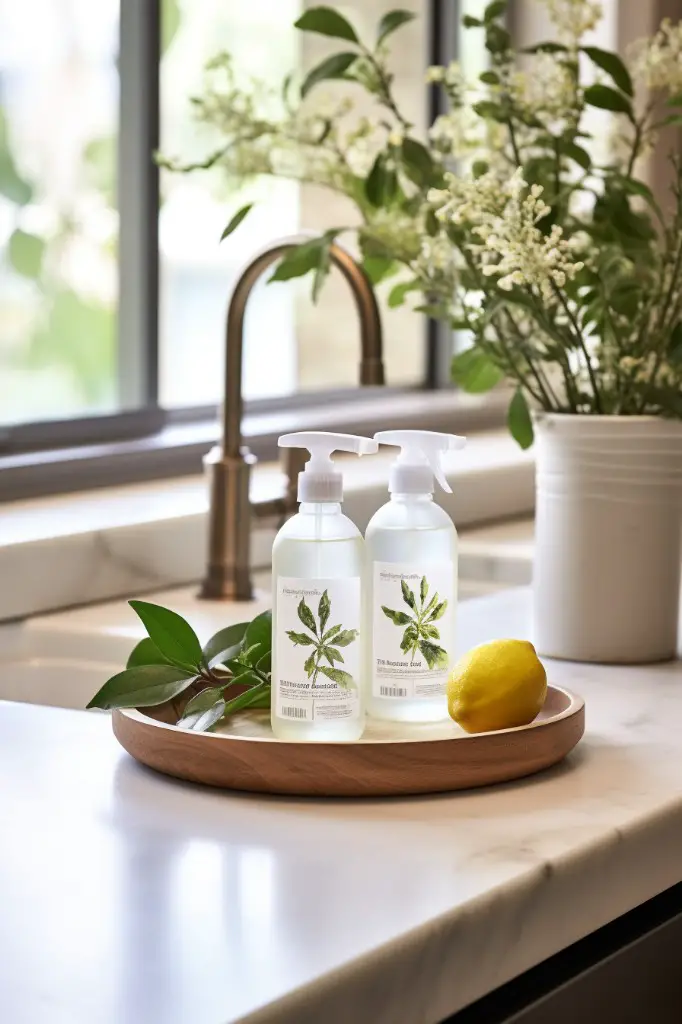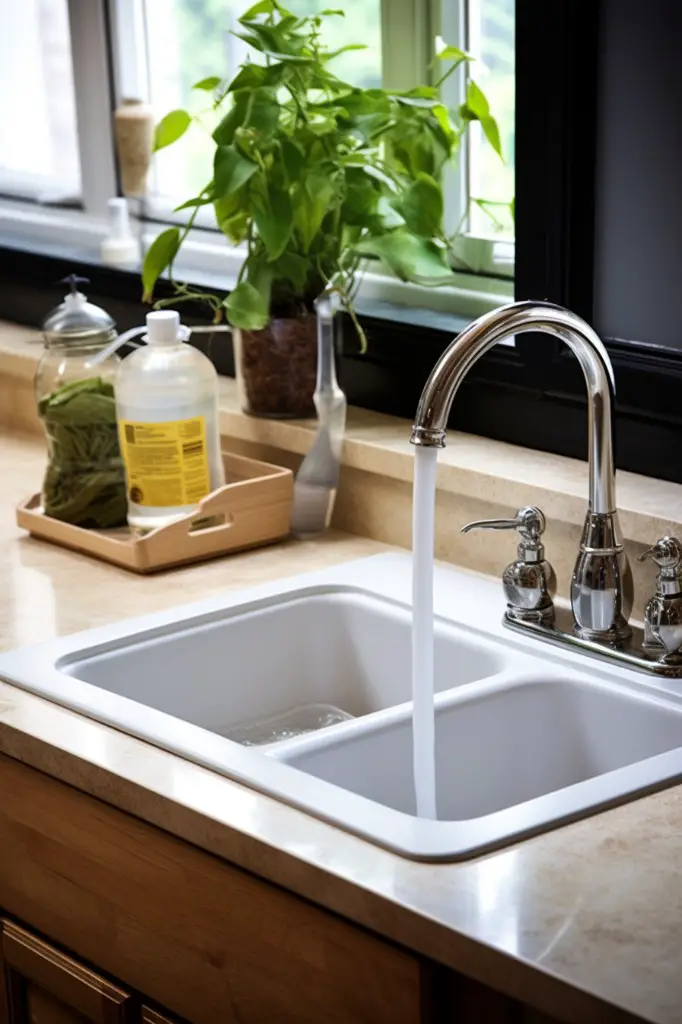Last updated on
Discover the simple and effective ways to disinfect your kitchen sink without using bleach, ensuring a clean and safe environment for you and your family.
The kitchen sink is the busiest place in your home, and it’s where most of the food preparation happens. It’s also a breeding ground for bacteria and germs that can cause illnesses.
While bleach is a popular disinfectant, not everyone wants to use it due to its harsh chemicals. Fortunately, there are other ways to keep your kitchen sink clean and germ-free without using bleach.
In this article, we’ll share some tips on how to disinfect your kitchen sink naturally so you can maintain a healthy home environment without compromising on safety or health concerns. So let’s get started!
What's Inside
Importance of Disinfecting Kitchen Sink

The kitchen sink is one of the most frequently used areas in your home, and it’s also a breeding ground for bacteria and germs. It’s where you wash your hands, clean dishes, rinse fruits and vegetables, dispose of food scraps – all activities that can leave behind harmful microorganisms.
These germs can cause illnesses such as diarrhea or food poisoning if they are not properly cleaned up.
Disinfecting your kitchen sink regularly is crucial to maintaining a healthy environment in your home. By doing so, you’ll be able to eliminate harmful bacteria that could potentially make you or someone else sick.
Moreover, disinfection helps prevent cross-contamination between different foods during meal preparation.
While bleach has been traditionally used as an effective disinfectant for sinks due to its strong antimicrobial properties; however many people prefer natural alternatives because bleach contains harsh chemicals which may pose health risks when ingested accidentally by children or pets.
Dangers of Using Bleach

Bleach can be dangerous if not used properly. Bleach contains harsh chemicals that can cause skin irritation, respiratory problems, and even chemical burns if it comes into contact with the skin or eyes.
Inhaling bleach fumes can also lead to coughing, wheezing and other respiratory issues.
Moreover, when mixed with certain substances such as ammonia or vinegar (which are commonly found in household cleaning products), bleach produces toxic gases that are harmful when inhaled.
In addition to health risks associated with using bleach for disinfection purposes; it’s also known for damaging surfaces over time due to its corrosive nature. This damage may result in discoloration of sinks and countertops which will require costly repairs or replacements.
Alternatives to Bleach

There are several alternatives to bleach that you can use to keep your sink clean and germ-free.
One of the most effective alternatives is vinegar. Vinegar has natural antibacterial properties that make it an excellent cleaner and disinfectant.
You can mix equal parts water and white vinegar in a spray bottle, then spray the solution onto your sink surface before wiping with a cloth or sponge.
Another alternative is baking soda, which also has natural cleaning properties. Mix baking soda with water until you have a paste-like consistency, then apply this mixture to your sink surface using a soft-bristled brush or sponge.
Hydrogen peroxide solution is another great alternative for those who want something stronger than vinegar but less harsh than bleach. Mix equal parts hydrogen peroxide (3%) with water in a spray bottle, then apply this solution onto your kitchen sink surfaces before wiping them down thoroughly.
Other options include rubbing alcohol solutions (70% concentration), lemon juice mixed with salt scrubbing paste or boiling hot water poured into the drain after washing dishes as well as dish soap diluted in warm water used regularly on all surfaces of sinks including drains will help prevent bacteria growth without harming pipes like some other cleaners might do over time!
Materials You Will Need for Disinfection

The good news is that most of these items are probably already in your home.
Here’s what you’ll need:
- White vinegar
- Baking soda
- Hydrogen peroxide solution (3%)
- Lemon juice or essential oil
- Salt
- Rubbing alcohol (70%)
- Boiling water
In addition to these ingredients, you’ll also need a few cleaning tools such as a scrub brush or sponge and gloves to protect your hands during cleaning.
Vinegar and Baking Soda Method
Vinegar is a mild acid that has antimicrobial properties, while baking soda is an alkaline substance that helps to neutralize odors and remove stains. When combined, they create a powerful cleaning solution that can effectively kill germs and bacteria.
To use this method, start by pouring some baking soda into the sink drain followed by vinegar. The mixture will fizz up as it reacts with each other; let it sit for about 10-15 minutes before rinsing with hot water.
For the surface of the sink itself, sprinkle some baking soda on a damp cloth or sponge then wipe down all surfaces of your kitchen sink thoroughly. Next, spray undiluted white vinegar onto those same surfaces until you see bubbles forming from the reaction between these two substances – this means they’re working together! Let everything sit for another 10-15 minutes before rinsing off with hot water.
Using Hydrogen Peroxide Solution
It’s an effective alternative to bleach, and it doesn’t contain any harsh chemicals that could harm you or the environment.
To use hydrogen peroxide solution for disinfection, mix equal parts of 3% hydrogen peroxide with water in a spray bottle. Spray the solution onto your sink surface and let it sit for about 10 minutes before rinsing thoroughly with warm water.
You can also add a few drops of essential oils like tea tree oil or lavender oil to enhance its cleaning power and leave behind a pleasant scent.
Remember not to mix hydrogen peroxide with vinegar as this combination creates harmful fumes. Also, avoid using undiluted hydrogen peroxide as it may damage some surfaces such as marble countertops.
Lemon and Salt Scrub
Lemon has antibacterial properties that can kill germs, while salt acts as a natural abrasive that helps remove stains and grime from the sink surface.
To make this scrub, cut a lemon in half and sprinkle some coarse salt on it. Then use the lemon as a scrubber to clean the entire sink surface thoroughly.
Pay special attention to areas with stubborn stains or buildup.
After you’ve finished scrubbing, rinse off the sink with warm water and dry it with a clean cloth or paper towel. Your kitchen sink will be sparkling clean, fresh-smelling, and germ-free!
Using Rubbing Alcohol
It contains a high percentage of isopropyl alcohol, which has antimicrobial properties that kill germs and bacteria on contact. To use rubbing alcohol for disinfection, you will need a spray bottle filled with 70% rubbing alcohol solution.
To begin the process, remove any debris or food particles from the sink using warm water and dish soap. Rinse thoroughly with hot water to ensure all residue is removed before proceeding.
Next, spray the entire surface of your kitchen sink generously with rubbing alcohol solution until it’s completely saturated. Allow it to sit for at least five minutes so that it can penetrate deep into any crevices where bacteria may be hiding.
Afterward, rinse off the rubbing-alcohol-treated area thoroughly using hot water again; this will help remove any remaining dirt or grime left behind by previous cleaning efforts while also ensuring complete removal of all traces of rubbings alcohols from surfaces in contact with food items such as dishes or utensils.
Disinfecting With Boiling Water
It’s a simple, effective, and affordable way to keep your sink clean without using harsh chemicals. To disinfect with boiling water, start by removing any debris or food particles from the sink surface.
Then boil a pot of water on the stove for at least five minutes to ensure it reaches 212°F (100°C). Carefully pour the hot water down the drain first to sanitize it before pouring over all surfaces of your kitchen sink.
Be careful when handling boiling water as it can cause burns if not handled properly. Also note that this method may not be suitable for certain types of sinks such as those made from plastic or other heat-sensitive materials.
Disinfecting with boiling water is an easy and effective way to maintain a clean and germ-free kitchen environment without resorting to harsh chemicals like bleach.
Cleaning Sink With Dish Soap
It’s gentle on the surface of the sink, yet effective in removing dirt, grime, and bacteria. To use dish soap for cleaning your kitchen sink:
1. Start by rinsing the sink with hot water to remove any loose debris or food particles.
2. Squirt a small amount of dish soap onto a sponge or cloth.
3. Scrub all areas of the sink thoroughly using circular motions.
4. Pay extra attention to areas around drains and corners where dirt tends to accumulate.
- Rinse off all traces of dish soap from the surface using hot water until no suds remain.
- Dry it completely with a clean towel or microfiber cloth after washing it properly.
Disinfecting Kitchen Sink With DIY All-purpose Cleaning Solution
This method involves creating a natural and safe cleaning solution that can be used on various surfaces in your home, including the kitchen sink. To make this solution, you will need some basic ingredients such as white vinegar, water, and essential oils like tea tree or lemon oil.
To create the all-purpose cleaner:
- Mix equal parts of water and white vinegar in a spray bottle.
- Add 10-15 drops of essential oil to the mixture.
- Shake well before use.
Spray this mixture onto your kitchen sink surface generously and let it sit for about 5-10 minutes before scrubbing with a sponge or brush thoroughly.
This DIY all-purpose cleaner is an excellent alternative to bleach-based cleaners because it’s non-toxic yet highly effective at killing germs and bacteria while leaving behind no harmful residue on surfaces after use.
Cleaning and Disinfecting Sink Drains
Over time, food particles, grease, and other debris can accumulate in your drain pipes. This buildup can lead to unpleasant odors and even clogs that are difficult to remove.
To clean your sink drains effectively, start by removing any visible debris from the surface of the drain using a paper towel or cloth. Next, pour a cup of baking soda down each drain followed by a cup of vinegar.
Let this mixture sit for about 10 minutes before flushing with hot water.
For stubborn clogs or persistent odors in your drains, you may need to use an enzyme-based cleaner specifically designed for sinks and drains. These cleaners work by breaking down organic matter like food particles so they can be easily flushed away.
Step-by-Step Guide for Disinfecting Kitchen Sink
Here’s a step-by-step guide to help you disinfect your kitchen sink without bleach:
Step 1: Remove any debris or food particles from the sink.
Step 2: Rinse the entire surface of the sink with hot water.
Step 3: Sprinkle baking soda all over the surface of the wet sink, and let it sit for about five minutes.
Step 4: Scrub gently with a soft-bristled brush or sponge, paying attention to areas around drains and faucet fixtures.
Step 5: Rinse thoroughly with hot water until all traces of baking soda are gone.
Step6: Pour vinegar into a spray bottle and spritz it onto every part of your clean but still dampened kitchen basin. Step7: Let this solution sit on for at least ten minutes before rinsing off again using warm running water.
That’s it! Your kitchen basin should now be disinfected naturally without harsh chemicals like bleach.
Preventing Bacteria and Germs in the Sink
Here are some tips to keep your sink clean:
1. Clean as you go: Wash dishes immediately after use, wipe down surfaces regularly with a damp cloth or sponge.
2. Use a strainer: A strainer can help catch food particles that could otherwise accumulate in the drain.
3. Avoid pouring grease down the drain: Grease can solidify and clog pipes, leading to unpleasant odors and potential health hazards.
4. Rinse thoroughly: After washing dishes or cleaning up spills, rinse your sink thoroughly with hot water for at least 30 seconds.
5. Keep sponges clean: Sponges are notorious for harboring bacteria; replace them frequently or sanitize them by microwaving on high for one minute every few days.
Frequency of Disinfection
How often should you do it? The frequency of disinfection depends on how frequently you use your sink, what kind of food preparation takes place in it, and whether or not there are any sick people in the house.
If you use your kitchen sink multiple times a day for cooking and cleaning dishes, then it’s recommended that you disinfect it at least once a day. If someone in the household is sick or has a weakened immune system, then more frequent cleaning may be necessary.
On the other hand, if your kitchen sink doesn’t get much use or only used occasionally for light tasks like washing fruits and vegetables; then weekly disinfection would suffice.
Remember that prevention is better than cure when dealing with germs. So make sure to clean up spills immediately after they occur so as not to give bacteria time to grow.
Also avoid leaving dirty dishes piled up in the sink overnight as this can create an ideal breeding ground for harmful microorganisms.
Safety Precautions During Disinfection
Here are some tips that you should keep in mind while disinfecting your kitchen sink:
1. Wear gloves: Always wear rubber gloves before starting the cleaning process as they protect your hands from harsh chemicals and hot water.
2. Avoid mixing chemicals: Never mix different cleaning solutions as they can produce harmful fumes that can cause respiratory problems.
3. Proper ventilation: Make sure there is proper ventilation in the area where you’re working, especially if using strong chemical cleaners like rubbing alcohol or hydrogen peroxide.
4. Keep children and pets away: Keep children and pets away from the area where you’re working until everything has been cleaned up properly.
5. Follow instructions carefully: Read all labels on cleaning products carefully before use, follow instructions for dilution rates, application methods etc., to ensure safe usage of these products.
Proper Sink Maintenance and Care
It also involves proper maintenance and care to ensure its longevity. Here are some tips on how to take care of your kitchen sink:
1. Avoid using abrasive cleaners or scrubbers that can scratch the surface of your sink.
2. Rinse the sink after each use, especially if you’ve used acidic foods like citrus fruits or vinegar.
3. Don’t leave standing water in the sink for too long as it can cause stains and discoloration over time.
4. Use a soft cloth or sponge when cleaning your sink, avoiding steel wool pads that can damage its finish.
5. Regularly check for leaks under the faucet or around drain pipes, fixing them immediately to prevent further damage to your plumbing system.
Tips for Maintaining a Clean Sink
It’s also important to keep it free from stains, scratches, and odors. Here are some tips for maintaining a clean sink:
1. Rinse the Sink After Each Use: Make sure to rinse your sink after each use with warm water and dish soap.
2. Avoid Leaving Dirty Dishes in the Sink: Leaving dirty dishes in the sink can cause bacteria buildup and unpleasant smells.
3. Use Soft Sponges or Cloths: Abrasive sponges or cloths can scratch your sink’s surface, making it more difficult to clean.
4. Don’t Pour Grease Down The Drain: Grease can solidify inside pipes causing blockages that lead to bad odors emanating from your drain.
5. Clean Your Sink Regularly: Clean your kitchen sinks at least once every week using natural cleaning agents like vinegar solution or baking soda paste.
Ensuring a Clean and Germ-free Kitchen Sink
First, make sure to wash your hands before and after handling food or using the sink. This will prevent the transfer of bacteria from your hands onto the sink surface.
Secondly, avoid leaving dirty dishes in the sink for an extended period as this can lead to bacterial growth. Instead, rinse them off immediately after use or place them in a dishwasher.
Thirdly, regularly wipe down your kitchen counters with disinfectant wipes or spray cleaner since they are often adjacent to sinks and can harbor germs that may spread back into the basin.
Lastly but not least important is cleaning sponges frequently by microwaving damp sponges for 30 seconds on high power every other day; this kills most bacteria present on it.
FAQ
What can I use to disinfect without bleach?
You can use 3% hydrogen peroxide as a non-toxic cleaner, whitener, and disinfectant, making it an excellent alternative to bleach for bathrooms, laundry, kitchens, and surfaces.
How do you disinfect a kitchen sink drain?
To disinfect a kitchen sink drain, pour a cup of baking soda down the drain, rinse with hot water, add lemon juice or distilled white vinegar for extra odor-fighting, and after 30 minutes, rinse the sink and drain again.
How do you disinfect a sink with vinegar?
To disinfect a sink with vinegar, simply spray a mixture of equal parts vinegar and water onto the sink, then rinse with soapy water to counteract the vinegar smell.
Does boiling water disinfect a sink?
Yes, boiling water disinfects a sink by killing most bacteria in approximately 10 minutes.
What are some natural alternatives to bleach for disinfecting kitchen surfaces?
Some natural alternatives to bleach for disinfecting kitchen surfaces include using vinegar, lemon juice, or tea tree oil.
How effective is hydrogen peroxide in disinfecting a kitchen sink?
Hydrogen peroxide is effective in disinfecting a kitchen sink as it can kill bacteria, viruses, and other germs.
Can baking soda be used to sanitize a kitchen sink effectively?
Baking soda can be used to clean a kitchen sink effectively, but it doesn’t possess sanitizing properties.




